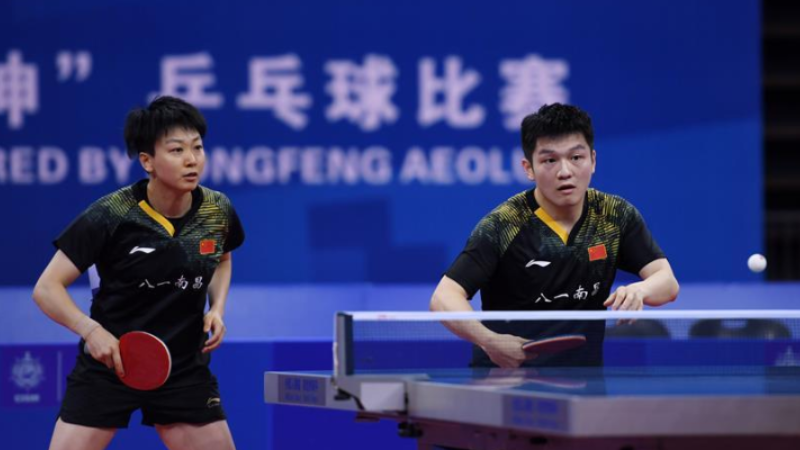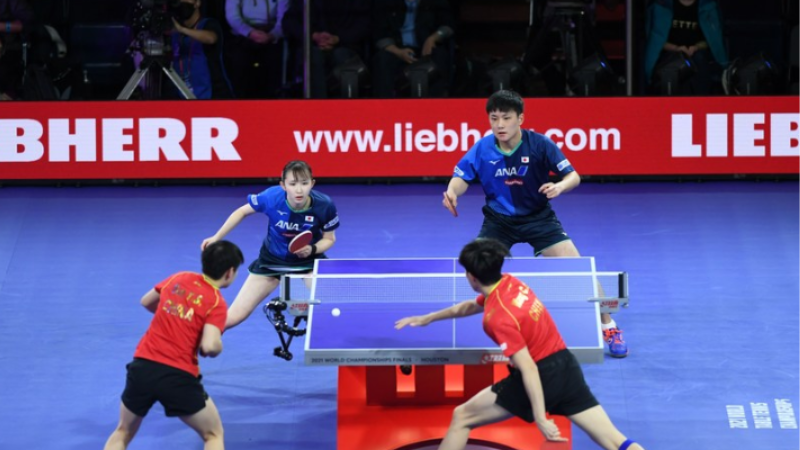Have you ever watched an official table tennis doubles match? If so, you may have wondered what the exact double table tennis rules are.
The rules for a singles match in table tennis can also be very complicated for many spectators and new players.
In this article, we will explain the most important rules for table tennis doubles.
6 Most Important Rules in Doubles Table Tennis
Understanding the key rules of doubles table tennis is essential for playing effectively and enjoying the game with a partner.
1. Serve and Side Selection
In a real competitive game, a coin toss usually determines which team gets to serve first.
In less important games, the referees or players themselves hold a single table tennis ball behind their back and let the teams or the opposing doubles team guess which hand is holding the ball.
The team that wins the draw or guesses the ball correctly may decide which doubles pair will serve first or which side of the table tennis table their team would like to be on first. The other doubles pair may then make the other decision:
- If team A decides which team gets to serve first, team B chooses one of the two sides of the table.
- If team A chooses one of the two sides of the table, team B is responsible for deciding which team will serve first.

2. Serve
Essentially, the same double ping pong rules apply to the serve during a table tennis doubles match as for a singles match. Also, you can read about the rules and regulations of traditional table tennis.
However, there are some serious differences:
In contrast to a singles match in table tennis, in a doubles match, the ball must first touch the right side of your half of the court and then touch the diagonally opposite side of the opposing doubles team.
The first team to serve may decide which player in their doubles team will serve first. This player may then serve two times in succession.
The opposing team then receives the right to serve, and the player who has just returned the two serves must now make two serves, which player B of doubles 1 accepts.
3. Return of Serve
One of the things that makes doubles unique is that players have to serve and return the ball in a very precise order.
This helps to ensure that all players have the opportunity to hit, especially because some players tend to be more aggressive than others. To illustrate this often confusing aspect of table tennis doubles, take a look at the following example:
- The team (team A or team B) that is allowed to serve first may decide which player of the doubles team (player 1 or player 2) serves first. Let’s assume that team A serves first and decides that player 1 serves first.
- The team that does not serve first, in this case team B, may decide which player (player 3 or player 4) will return the serve. The team decides that player 3 will return player 1’s serve.
- Player 1 serves by the rules, and player 3 returns the ball.
- As soon as the ball has landed on Team A’s side of the table, Player 2 must touch the ball so that it lands on Team 2’s side of the table.
- As soon as the ball has landed on team B’s side of the table, it is player 4’s turn to hit it.
- On team A’s side of the table, player 4 is responsible for playing the ball again. This cycle continues until a doubles team scores a point. If a doubles pair does not follow the sequence, the opposing doubles pair scores a point.
Exception: However, there is a specific case in which this order can be relaxed. In games with disabled participants, anyone from the opposing team can return the ball.

4. Change of Serve
A team has the opportunity to serve twice before the opposing team has the opportunity to serve twice. Exception: In the extra set (from the score 10:10), each doubles pair has only one serve at a time.
If all serves are exhausted, the previous returner becomes the server and the partner of the previous server becomes the returner. I would also like to illustrate this with an example:
- Player 1 plays two serves to player 3
- Player 3 plays two serves to player 2
- Player 2 plays two serves to player 4
- Player 4 plays two serves to player 1
- Player 1 plays two serves to player 3
- …
This sequence is maintained throughout the entire sentence.
5. Change of Sides
As a rule, a table tennis match lasts up to 5 sets or 7 sets. This means that the first doubles pair to win 3 sets or 4 sets has won the whole match.
After each set, as in singles, the sides are swapped. Each time, the pair that served first in the previous set decides which player of their doubles team will serve.
The return server is then the player of the opposing doubles team who served to the new server in the previous set. I will also explain this using an example:
- If team 1 had the first serve in the previous set, team 2 now has the first serve and can decide which player serves first. Let’s assume that player 3 serves first.
- In the previous set, player 3 took player 1’s serve. Therefore, player 1 now accepts player 3’s serve.
- Player 1 plays two serves to player 4
- Player 4 plays two serves to player 2
- Player 2 plays two serves to player 3
- Player 3 plays two serves to player 1
- …
This runs through the entire game to ensure that everyone can fulfill every role. It also prevents a doubles pairing where only the player who is supposedly better at serving serves serves.
In a deciding set (fifth or seventh set), the sides are also switched as soon as one of the doubles has reached five points. Here, the serve and return sequence is also changed in exactly the same way as at the end of a set.
6. Scoring
As in a singles match, the doubles team that reaches 11 points first wins a set. At the end of the set, however, there must be a gap of at least two points between the doubles pairings.
So if the score is 10 to 10, the set continues to be played until one of the two pairs has a two-point lead.
But how can you collect points in a table tennis doubles match? Well, there are a few ways in which a team can score points in the race to win the match.
- In particular, as in singles, the opposing doubles pair is awarded a point if you play a wrong serve or a wrong return, or if the ball hit by the other doubles pair crosses the baseline without first touching the table.
- As a special rule, you should note here (as mentioned above for the serve) that you must play your serve diagonally and that it must first touch your own right side of the table.
- Another special feature of doubles is that the opposing doubles team scores a point if the ball is played outside the specified stroke sequence. For example, if a doubles player plays the ball twice in succession.
Strategies and Tactics of Double Table Tennis
Players must not only rely on their skills but also coordinate their efforts with their partners to outmaneuver the opposing team.

Here are some common strategies and tactics in doubles play:
Setting up Your Partner
One of the primary strategies in doubles is to set up your partner for a winning shot. This involves using well-placed shots to create opportunities for your teammate to attack.
For example, a player might aim to hit a shot deep into the corner of the table to force the opponents into a defensive position, allowing their partner to capitalize on the open space with a powerful offensive shot.
Quick Exchanges
Doubles teams often use quick exchanges, also known as rallies, to keep opponents off balance.
By maintaining a fast-paced tempo and alternating shots rapidly between teammates, they can pressure the opposing team and prevent them from settling into a comfortable rhythm.
Quick exchanges can also exploit gaps in the opponents’ defense and force errors.
Targeting the Weaker Player
Another common tactic is identifying and targeting the weaker player on the opposing team. By focusing their attacks on this player, doubles teams can put additional pressure on them and exploit any vulnerabilities in their game.
This might involve directing shots towards their backhand, exploiting their slower reaction times, or testing their consistency under pressure.
Adapting to Opponents
Successful doubles teams understand the importance of adapting their tactics based on the strengths and weaknesses of their opponents.
This might involve making adjustments mid-match, such as changing the placement or pace of shots, to exploit emerging opportunities or counteract the opponents’ strategies.
For example, if the opposing team excels at aggressive attacking play, a doubles team might opt for a more defensive strategy focused on consistency and placement.
Communication and Coordination
Effective communication between doubles partners is very important for implementing strategies and tactics successfully. Players must coordinate their movements, shot selection, and positioning on the court to ensure seamless teamwork.
Clear and concise communication can help players anticipate each other’s actions and react quickly to changing situations, whether through verbal cues or pre-established signals.
Maintaining Pressure
Doubles teams often seek to maintain pressure on their opponents throughout the match.
By consistently applying pressure with aggressive shot-making, strategic placement, and relentless attacking play, they can force errors, create openings, and ultimately control the flow of the game.
Maintaining pressure can also disrupt the opponents’ rhythm and confidence, making it more difficult for them to execute their own strategies effectively.
Conclusion on Double Table Tennis Rules
In doubles table tennis, players need to know different rules from singles. Double table tennis rules make the game more about strategy.
These rules can be hard to get at first. But once you know them, you’ll enjoy doubles table tennis more. You’ll also play better. Understanding these rules is key whether you’re new to the game or have played for a while.
Double Table Tennis Rules – F.A.Q
Do you have to alternate in table tennis doubles❓
In a rally, doubles partners are required to take turns hitting the ball, regardless of its placement on the table.
What is the difference between singles and doubles in table tennis❓
The main difference between singles and doubles in table tennis is the number of players on each side of the table. This difference affects strategies, court coverage, and communication between players.
Can players switch sides during a doubles match❓
No, players must remain on their designated sides throughout the match.
How do players decide who serves first in doubles❓
A coin toss or a guessing game usually determines which team serves first.
Are there specific serving rules for doubles❓
Yes, the serve must first touch the server’s right half of the court and then the diagonally opposite side of the opponents’ court.
Can any player return the serve in doubles❓
Typically, the player designated by the opposing team returns the serve, but there are exceptions for games involving disabled participants.
How often can a team serve in doubles❓
Each team serves twice in succession before the opposing team gets a chance to serve.
Is there a specific sequence for changing sides during a match❓
Yes, sides are changed after each set, with the serving team deciding who serves first on the new side.
What happens if a doubles team breaks the serving order❓
The opposing team scores a point if a doubles pair fails to follow the correct sequence of serves and returns.
How is scoring handled in a doubles match❓
The first team to reach 11 points wins a set, with a minimum two-point gap required for victory. Matches typically consist of 3 or 5 sets.
Doubles ping pong rules is the same like doubles table tennis ❓
Yes, doubles ping pong rules are the same as doubles table tennis rules. “Ping pong” is simply a more informal term for table tennis, but the rules for doubles play remain identical in both contexts.